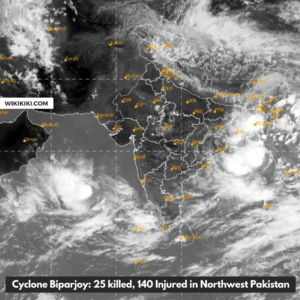Cyclone Biparjoy has swept through Pakistan’s northwest, causing several houses to collapse and resulting in at least 25 deaths and 145 injuries. The Cyclone Biparjoy affected districts include Bannu, Lakki Marwat, and Karak in the Khyber Pakhtunkhwa province. The heavy rains uprooted trees and knocked down electrical transmission towers.
Emergency relief efforts are underway to assist the injured. The government has allocated USD 1.3 billion for climate resilience in its national budget draft to mitigate the effects of natural disasters. Prime Minister Shahbaz Sharif expressed grief over the loss of life and directed authorities to accelerate the relief operation. Additionally, preparations are being made for the approaching cyclone Biparjoy, which is expected to become an extremely severe cyclonic storm.
Also Read: Haiti Floods: 15 Dead and 8 Reported Missing After Deadly Floods

Pakistan has recently been hit by a deadly combination of heavy rain and the approaching cyclone Biparjoy, resulting in widespread devastation and loss of life. The northwest region, particularly the districts of Bannu, Lakki Marwat, and Karak in Khyber Pakhtunkhwa province, bore the brunt of the natural disaster.
As houses collapsed, trees uprooted, and electrical transmission towers fell, at least 25 people lost their lives, while 145 others sustained injuries. The country, still reeling from the aftermath of last year’s devastating monsoon floods, is faced with yet another crisis that demands urgent attention and relief efforts.
The heavy rain and hail that struck the northwest region of Pakistan caused significant destruction in various districts. In Bannu, the loss of life was particularly high, with 15 people losing their lives and 100 others sustaining injuries. Additionally, 68 houses were partially damaged in the district. The torrential downpour also affected the districts of Lakki Marwat and Karak, resulting in five deaths and 42 injuries in Lakki Marwat, while four people lost their lives and one person sustained injuries in Karak. Furthermore, Dera Ismail Khan reported one casualty, two injuries, and partial damage to a house.
Also Read: Senegal Violence: Deadly Clashes in Following Opposition Leader’s Sentencing
The collapse of houses and the uprooting of trees and electrical transmission towers have severely disrupted the lives of the affected communities. Rescue operations are underway to provide emergency relief to the injured and to ensure the safe relocation of affected individuals. The Provincial Disaster Management Authority (PDMA) of Khyber Pakhtunkhwa, along with the National Disaster Management Authority (NDMA), has been mobilized to coordinate relief efforts and assess the extent of the damage.
Pakistan’s Climate and Cyclone Biparjoy
In the face of recurring natural disasters, the Pakistani government has recognized the need for enhanced climate resilience measures. In its national budget draft presented recently, the government allocated USD 1.3 billion to mitigate the effects of natural disasters. This allocation reflects the government’s commitment to addressing the challenges posed by climate change and protecting vulnerable communities from the impact of extreme weather events.
The funds will be utilized to enhance infrastructure resilience, improve early warning systems, and support disaster preparedness initiatives. By investing in climate resilience, Pakistan aims to minimize the loss of life and property caused by natural disasters and provide timely assistance to affected communities.
Prime Minister Shahbaz Sharif expressed deep grief over the loss of life and directed authorities to accelerate relief operations. Recognizing the imminent threat posed by cyclone Biparjoy, he instructed officials to implement emergency measures in advance. The cyclone, described as “severe and intense,” is expected to hit the southern part of the country with wind speeds of up to 150 kilometers per hour (93 miles per hour). To ensure the safety of the population, the disaster management agency of Pakistan has issued warnings and urged people to take necessary precautions.
The government, in coordination with local authorities and disaster management agencies, has launched a comprehensive relief operation to provide immediate assistance to the affected communities. Emergency relief efforts include medical aid, shelter provision, food distribution, and the restoration of essential services. The NDMA and PDMA are working tirelessly to ensure the effective coordination of relief efforts and the efficient utilization of resources.
Also Read: 6.2-Magnitude Earthquake Strikes New Zealand’s Auckland Islands
Pakistan has faced numerous natural disasters in the past, including devastating floods and earthquakes. These events have highlighted the importance of disaster preparedness and the need for long-term resilience strategies. Building on the lessons learned, the government is taking steps to strengthen disaster risk reduction measures and improve early warning systems.
Investing in infrastructure resilience, including robust housing construction and better urban planning, is crucial to minimize the impact of future disasters. Additionally, increasing public awareness and community participation in disaster management and response can enhance the country’s preparedness and ability to recover quickly.
Collaboration with international partners and organizations, such as the United Nations and regional bodies, can provide valuable expertise, resources, and support in disaster management. Sharing best practices and technical knowledge can contribute to the development of effective strategies to mitigate the impact of natural disasters.
The recent heavy rain, hail, and the approaching cyclone Biparjoy have once again put Pakistan’s resilience to the test. The loss of lives and the destruction of homes and infrastructure highlight the urgent need for comprehensive disaster preparedness and response mechanisms.
By investing in climate resilience, enhancing early warning systems, and promoting community engagement, Pakistan can better protect its population from the devastating effects of natural disasters. With a coordinated and proactive approach, the country can build a more resilient future and ensure the safety and well-being of its citizens in the face of increasingly frequent and severe weather events.
Also Read: Afghanistan Blast: 11 killed and 30 Injured Near Nabawi Mosque



















+ There are no comments
Add yours